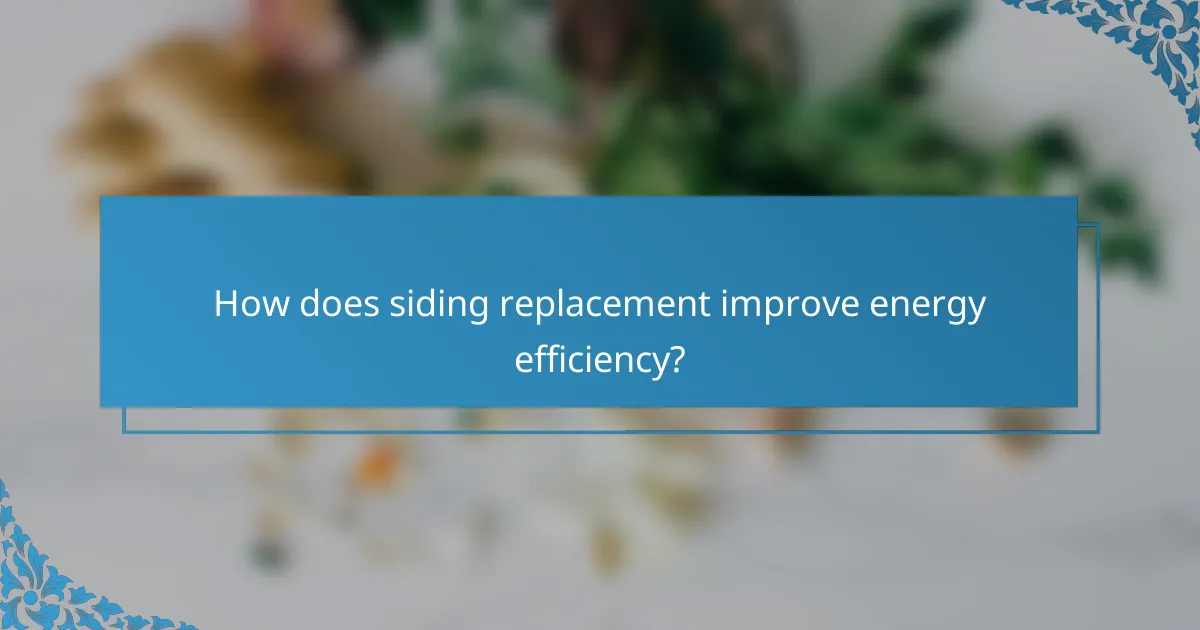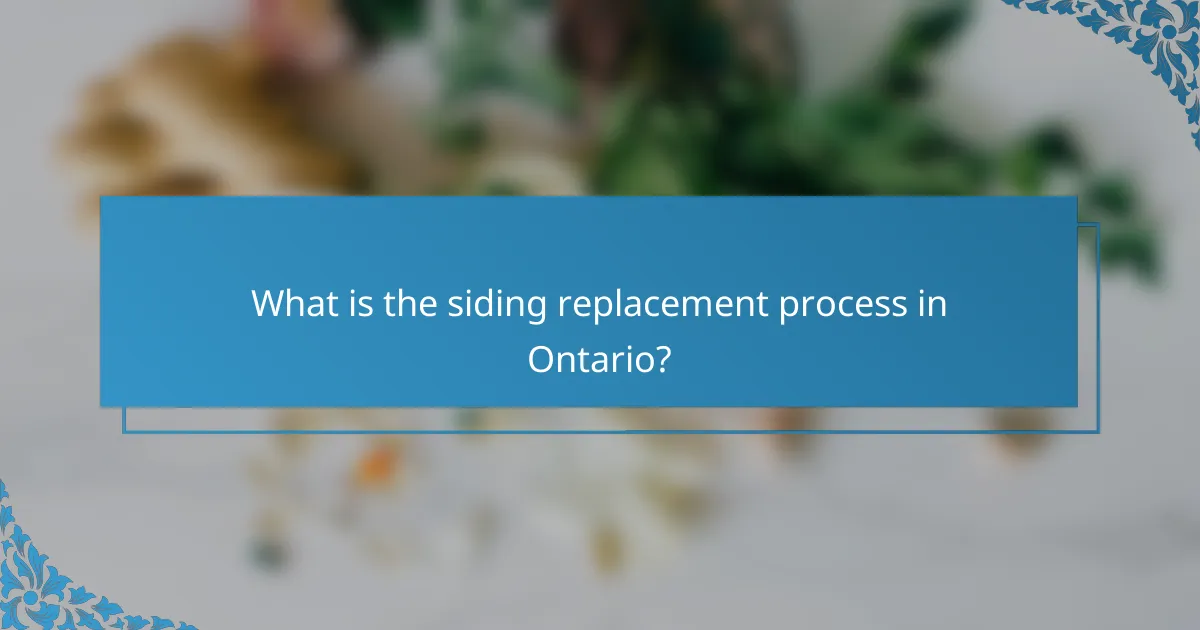Siding replacement is a valuable investment for homeowners, offering enhanced insulation, improved aesthetics, and reduced maintenance requirements. By upgrading to modern siding materials, you can boost your home’s energy efficiency, create a more visually appealing exterior, and minimize long-term upkeep costs.

What are the benefits of siding replacement in Toronto?
Siding replacement in Toronto offers significant advantages, including improved insulation, enhanced aesthetics, and reduced maintenance needs. These benefits can lead to increased energy efficiency, a more attractive home exterior, and lower long-term upkeep costs.
Enhanced insulation performance
New siding can greatly enhance your home’s insulation performance, helping to maintain a comfortable indoor temperature year-round. Modern materials, such as insulated vinyl or fiber cement, can reduce heat loss in winter and keep your home cooler in summer.
When considering siding options, look for products with high R-values, which indicate better thermal resistance. This improvement can lead to noticeable savings on energy bills, often reducing heating and cooling costs by a significant percentage.
Aesthetic upgrade options
Siding replacement provides an opportunity to upgrade your home’s exterior appearance. In Toronto, homeowners can choose from a variety of materials and styles, including wood, vinyl, and metal, each offering unique aesthetic benefits.
Consider selecting colors and textures that complement your neighborhood and personal taste. Popular trends include bold colors or natural wood finishes, which can enhance curb appeal and potentially increase property value.
Maintenance reduction strategies
Replacing old siding can significantly reduce maintenance requirements. New materials are often designed to resist fading, warping, and insect damage, which means less frequent repairs and repainting.
For example, fiber cement siding typically requires minimal upkeep compared to traditional wood siding. Regular cleaning with a garden hose is usually sufficient to maintain its appearance, allowing homeowners to save time and money on maintenance tasks.

How does siding replacement improve energy efficiency?
Siding replacement enhances energy efficiency by providing better insulation, reducing air leaks, and improving the overall thermal performance of a home. Upgrading to modern siding materials can significantly lower heating and cooling demands, leading to lower energy bills.
Insulation materials comparison
When considering siding replacement, it’s essential to compare different insulation materials. Options like vinyl, fiber cement, and insulated vinyl siding offer varying levels of thermal resistance. Insulated siding typically has a higher R-value, which measures insulation effectiveness, making it a better choice for energy efficiency.
For example, insulated vinyl siding can provide an R-value of around 3 to 5, while traditional vinyl may only offer an R-value of about 1 to 2. This difference can lead to noticeable improvements in energy retention within the home.
Impact on heating and cooling costs
Replacing siding can significantly impact heating and cooling costs by minimizing energy loss. Homeowners may experience reductions in energy bills by 10% to 20% after installing energy-efficient siding. This is particularly beneficial in regions with extreme temperatures, where heating and cooling demands are high.
To maximize savings, consider the local climate when choosing siding materials. For instance, homes in colder areas may benefit more from insulated options, while those in milder climates might find standard vinyl sufficient. Regular maintenance of the siding can further enhance its energy efficiency over time.

What types of siding are available for replacement?
There are several types of siding available for replacement, each offering distinct benefits and aesthetic options. Common choices include vinyl, wood, and fiber cement siding, which vary in terms of insulation, maintenance needs, and visual appeal.
Vinyl siding advantages
Vinyl siding is popular due to its affordability and low maintenance requirements. It is resistant to moisture and pests, making it a practical choice for many homeowners.
Additionally, vinyl siding comes in a wide range of colors and styles, allowing for customization to match various architectural designs. Its insulation properties can also help improve energy efficiency, potentially lowering heating and cooling costs.
Wood siding options
Wood siding offers a classic, natural look that many homeowners find appealing. It can be painted or stained in various colors, providing flexibility in design.
However, wood requires regular maintenance, such as painting or sealing, to protect against rot and insect damage. It’s important to consider the climate when choosing wood siding, as some types may perform better in specific weather conditions.
Fiber cement siding features
Fiber cement siding combines the durability of cement with the aesthetic appeal of wood. It is resistant to fire, pests, and rot, making it a long-lasting option.
This type of siding can mimic the appearance of wood or stucco and is available in various colors. While it may be more expensive upfront than vinyl or wood, its longevity and low maintenance can make it a cost-effective choice over time.

What is the siding replacement process in Ontario?
The siding replacement process in Ontario involves several key steps, starting with an assessment of the existing siding and ending with the installation of new materials. Homeowners should consider factors such as insulation, aesthetics, and maintenance when planning their project.
Initial consultation steps
The initial consultation typically begins with a meeting between the homeowner and a siding contractor. During this meeting, the contractor evaluates the current siding condition, discusses the homeowner’s preferences, and provides recommendations based on insulation needs and aesthetic goals.
Homeowners should prepare by gathering inspiration images and considering their budget, as this will help guide the discussion. It’s also beneficial to ask about the types of siding materials available, such as vinyl, wood, or fiber cement, and their respective advantages.
Installation timeline overview
The installation timeline for siding replacement in Ontario can vary, but most projects take about one to two weeks from start to finish. Factors influencing the timeline include the size of the home, the type of siding chosen, and weather conditions.
After the initial consultation, homeowners can expect a detailed schedule outlining the installation phases, including material delivery, removal of old siding, and installation of the new siding. It’s important to communicate with the contractor about any potential delays and to ensure that all permits are secured before work begins.

What permits are required for siding replacement in Canada?
In Canada, siding replacement typically requires a building permit, which ensures compliance with local building codes and regulations. The specific requirements can vary by province and municipality, so it’s essential to check with local authorities before starting any work.
Building permit requirements
Most municipalities in Canada require a building permit for siding replacement to ensure that the work meets safety and structural standards. The application process usually involves submitting plans that detail the materials and methods to be used, along with any necessary fees. It’s advisable to apply for the permit well in advance, as processing times can vary.
In some cases, if the siding replacement is minor or like-for-like, a permit may not be necessary. However, it’s crucial to verify this with your local building department to avoid potential fines or issues during inspections.
Local regulations in Toronto
In Toronto, homeowners must obtain a building permit for siding replacement, especially if the work involves changes to the structure or materials. The city’s regulations require that all siding materials meet specific energy efficiency and fire safety standards. Additionally, any work done must comply with the Ontario Building Code.
Before starting, it’s wise to consult the City of Toronto’s website or contact the building permit office for detailed guidelines and to ensure all necessary documentation is prepared. This proactive approach can save time and prevent complications during the renovation process.

How much does siding replacement cost in Toronto?
Siding replacement in Toronto typically ranges from CAD 5,000 to CAD 15,000, depending on various factors such as material choice and home size. Homeowners should consider both the upfront costs and potential long-term savings from improved insulation and reduced maintenance.
Average pricing bands
The cost of siding replacement in Toronto can vary significantly based on the materials used. Vinyl siding often falls in the lower range, around CAD 5,000 to CAD 10,000, while higher-end materials like fiber cement or wood can range from CAD 10,000 to CAD 15,000 or more.
Installation costs can also influence the total price, with professional labor typically adding 20-30% to the overall expense. Homeowners should obtain multiple quotes to ensure competitive pricing.
Factors affecting cost
Several factors can affect the cost of siding replacement in Toronto. The size of the home is a primary consideration; larger homes will naturally require more materials and labor. Additionally, the complexity of the installation, such as the need for repairs or removal of old siding, can increase costs.
Material choice is another significant factor. While vinyl is cost-effective, premium materials like wood or fiber cement offer better durability and aesthetics but come with higher price tags. Lastly, local labor rates and seasonal demand can also impact overall pricing.

What are the best practices for siding maintenance?
Effective siding maintenance involves regular inspections, timely repairs, and appropriate cleaning methods to prolong the lifespan and performance of your siding. By following best practices, you can enhance insulation, improve aesthetics, and reduce maintenance needs.
Regular inspection tips
Conducting regular inspections of your siding is crucial for identifying potential issues early. Aim to inspect your siding at least twice a year, ideally in spring and fall, to check for signs of damage, such as cracks, warping, or mold growth.
During inspections, look for loose or missing pieces, especially after severe weather. Pay attention to areas around windows and doors, as these are common spots for water intrusion. If you notice any problems, address them promptly to prevent further damage.
Consider creating a checklist for your inspections, including items like checking for discoloration, peeling paint, and gaps between panels. This structured approach can help ensure you don’t overlook any critical areas during your maintenance routine.
